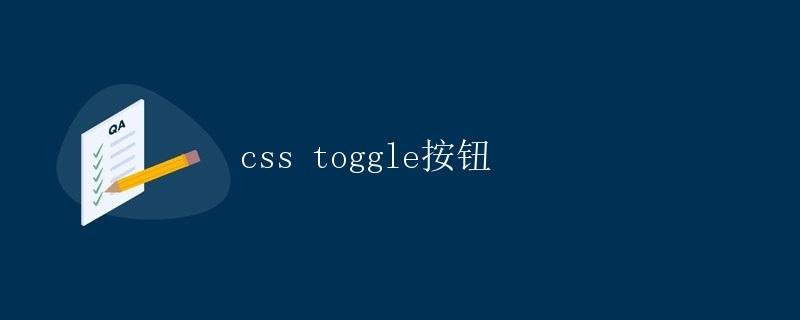CSS Toggle Button
CSS Toggle Button

In web development, a Toggle button is a common UI element used to switch the state of an option. By combining CSS and HTML, we can easily achieve the style and functionality of a toggle button. This article will detail how to create a simple toggle button using CSS, along with sample code and a demonstration of the effect.
HTML Structure
First, we need to create the basic structure of a toggle button in HTML. Typically, a toggle button consists of an <input> element and a corresponding <label> element. The <input> element receives user input, while the <label> element displays the clickable area of the button.
Here is an example of the HTML structure for a simple Toggle button:
<input type="checkbox" id="toggle">
<label for="toggle" class="toggle-btn"></label>
In the above code, we create an <input> element and set its type to checkbox, which enables the toggle button to be checked and unchecked. Next, we create a <label> element and associate it with the <input> element. We use the for attribute to specify the corresponding id value. This way, clicking the <label> element toggles the <input> element’s checked state.
CSS Style
Next, we need to use CSS to style the toggle button. We can use CSS to set the background color, size, border and other styles of the Toggle button, as well as the styles of the hover and selected states.
Here is a simple CSS style example for a Toggle button:
/* Toggle button container style */
.toggle-btn {
display: inline-block;
width: 50px;
height: 26px;
background-color: #dddddd;
border-radius: 20px;
position: relative;
cursor: pointer;
}
/* Toggle button circular button style */
.toggle-btn::before {
content: '';
display: block;
width: 22px;
height: 22px;
background-color: white;
border-radius: 50%;
position: absolute;
left: 2px;
top: 2px;
transition: 0.3s;
}
/* Toggle button checked state styles */
#toggle:checked + .toggle-btn::before {
transform: translateX(24px);
}
In the above code, we first set some basic styles for the toggle button container, including width, height, and background color. Then, we use the ::before pseudo-element to create the toggle button’s circular button style, setting its size, color, and position. Finally, we use the #toggle:checked + .toggle-btn::before selector to set the position of the toggle button in its checked state, and use the transform property to achieve the translation animation effect.
Complete Example
Combining the above HTML structure with CSS styles, we can create a complete toggle button effect.
<!DOCTYPE html>
<html lang="en">
<head>
<meta charset="UTF-8">
<meta name="viewport" content="width=device-width, initial-scale=1.0">
<title>CSS Toggle Button</title>
<style>
/* Toggle Button Container Style */
.toggle-btn {
display: inline-block;
width: 50px;
height: 26px;
background-color: #dddddd;
border-radius: 20px;
position: relative;
cursor: pointer;
}
/* Toggle Button Round Button Style */
.toggle-btn::before {
content: '';
display: block;
width: 22px;
height: 22px;
background-color: white;
border-radius: 50%;
position: absolute;
left: 2px;
top: 2px;
transition: 0.3s;
}
/* Toggle button selected state style */
#toggle:checked + .toggle-btn::before {
transform: translateX(24px);
}
</style>
</head>
<body>
<input type="checkbox" id="toggle">
<label for="toggle" class="toggle-btn"></label>
</body>
</html>
By running the above sample code, you can see a simple Toggle button in the browser. When you click the Toggle button, the circular button will translate within its container, implementing the basic functionality and style of the Toggle button.
Summary:
Through this article, we learned how to use CSS and HTML to create a simple toggle button and implemented its basic styling and functionality. By carefully applying styling techniques and using selectors, we can easily create a variety of toggle buttons with different styles and effects, adding richer and more dynamic interactive effects to web pages.